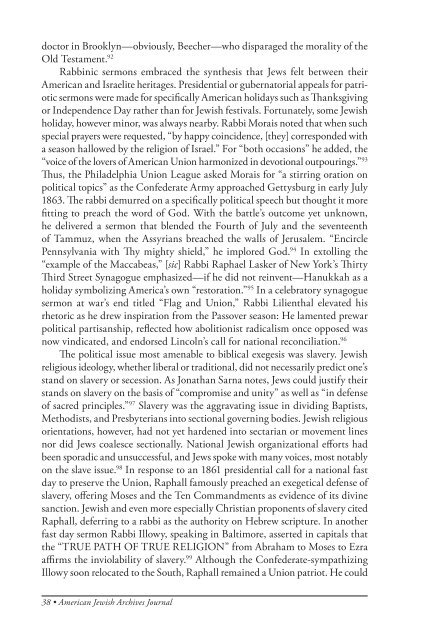American Jewish Archives Journal, Volume 64, Numbers 1 & 2
American Jewish Archives Journal, Volume 64, Numbers 1 & 2
American Jewish Archives Journal, Volume 64, Numbers 1 & 2
Create successful ePaper yourself
Turn your PDF publications into a flip-book with our unique Google optimized e-Paper software.
doctor in Brooklyn—obviously, Beecher—who disparaged the morality of the<br />
Old Testament. 92<br />
Rabbinic sermons embraced the synthesis that Jews felt between their<br />
<strong>American</strong> and Israelite heritages. Presidential or gubernatorial appeals for patriotic<br />
sermons were made for specifically <strong>American</strong> holidays such as Thanksgiving<br />
or Independence Day rather than for <strong>Jewish</strong> festivals. Fortunately, some <strong>Jewish</strong><br />
holiday, however minor, was always nearby. Rabbi Morais noted that when such<br />
special prayers were requested, “by happy coincidence, [they] corresponded with<br />
a season hallowed by the religion of Israel.” For “both occasions” he added, the<br />
“voice of the lovers of <strong>American</strong> Union harmonized in devotional outpourings.” 93<br />
Thus, the Philadelphia Union League asked Morais for “a stirring oration on<br />
political topics” as the Confederate Army approached Gettysburg in early July<br />
1863. The rabbi demurred on a specifically political speech but thought it more<br />
fitting to preach the word of God. With the battle’s outcome yet unknown,<br />
he delivered a sermon that blended the Fourth of July and the seventeenth<br />
of Tammuz, when the Assyrians breached the walls of Jerusalem. “Encircle<br />
Pennsylvania with Thy mighty shield,” he implored God. 94 In extolling the<br />
“example of the Maccabeas,” [sic] Rabbi Raphael Lasker of New York’s Thirty<br />
Third Street Synagogue emphasized—if he did not reinvent—Hanukkah as a<br />
holiday symbolizing America’s own “restoration.” 95 In a celebratory synagogue<br />
sermon at war’s end titled “Flag and Union,” Rabbi Lilienthal elevated his<br />
rhetoric as he drew inspiration from the Passover season: He lamented prewar<br />
political partisanship, reflected how abolitionist radicalism once opposed was<br />
now vindicated, and endorsed Lincoln’s call for national reconciliation. 96<br />
The political issue most amenable to biblical exegesis was slavery. <strong>Jewish</strong><br />
religious ideology, whether liberal or traditional, did not necessarily predict one’s<br />
stand on slavery or secession. As Jonathan Sarna notes, Jews could justify their<br />
stands on slavery on the basis of “compromise and unity” as well as “in defense<br />
of sacred principles.” 97 Slavery was the aggravating issue in dividing Baptists,<br />
Methodists, and Presbyterians into sectional governing bodies. <strong>Jewish</strong> religious<br />
orientations, however, had not yet hardened into sectarian or movement lines<br />
nor did Jews coalesce sectionally. National <strong>Jewish</strong> organizational efforts had<br />
been sporadic and unsuccessful, and Jews spoke with many voices, most notably<br />
on the slave issue. 98 In response to an 1861 presidential call for a national fast<br />
day to preserve the Union, Raphall famously preached an exegetical defense of<br />
slavery, offering Moses and the Ten Commandments as evidence of its divine<br />
sanction. <strong>Jewish</strong> and even more especially Christian proponents of slavery cited<br />
Raphall, deferring to a rabbi as the authority on Hebrew scripture. In another<br />
fast day sermon Rabbi Illowy, speaking in Baltimore, asserted in capitals that<br />
the “TRUE PATH OF TRUE RELIGION” from Abraham to Moses to Ezra<br />
affirms the inviolability of slavery. 99 Although the Confederate-sympathizing<br />
Illowy soon relocated to the South, Raphall remained a Union patriot. He could<br />
38 • <strong>American</strong> <strong>Jewish</strong> <strong>Archives</strong> <strong>Journal</strong>
















